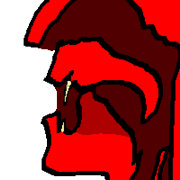Retroflex consonant
|
|
| Places of articulation |
| Labial |
| Bilabial |
| Labiodental |
| Linguolabial |
| Labial-velar |
| Coronal |
| Interdental |
| Dental |
| Retroflex |
| Alveolar |
| Postalveolar |
| Alveolo-palatal |
| Dorsal |
| Palatal |
| Labial-palatal |
| Velar |
| Uvular |
| Pharyngeal |
| Epiglottal |
| Glottal |
| Apical |
| Laminal |
| This page contains phonetic information in IPA, which may not display correctly in some browsers. [Help] |
| [Edit] (http://en.wikipedia.org/wiki/Template:Place_of_articulation?action=edit) |
Retroflex consonants cover two points of articulation. They are articulated in the postalveolar-palatal region, but are either apical or sub-apical, rather than laminal as the postalveolar and palatal consonants are. That is, in a retroflex articulation, either the tip of the tongue touches the postalveolar region (in Mandarin Chinese and Hindi), or it curls back so that the underside of the tip touches the roof of the mouth in the postalveolar-palatal region (in Tamil). Retroflex consonants identified by the International Phonetic Alphabet are:
| IPA | Description | Example | |||
|---|---|---|---|---|---|
| Language | Orthography | IPA | Meaning | ||

| retroflex nasal | Swedish | Vänern | [] | Vänern |

| voiceless retroflex plosive | Vietnamese | Nha Trang | [[[Template:IPA bold dark red]]] | Nha Trang |

| voiced retroflex plosive | Swedish | nord | [] | north |

| voiceless retroflex fricative | Mandarin | 上海 (Shànghǎi) | [] | Shanghai |

| voiced retroflex fricative | Mandarin | 朱镕基 (Zhū Róngjì) | [] | Zhu Rongji |

| retroflex approximant | Tamil | தமிழ் (Tamil) | [] | Tamil |
| Missing image Xsampa-l'.png Image:Xsampa-l'.png | lateral retroflex approximant | Swedish | Karlstad | [] | Karlstad |

| retroflex flap | Hausa | shaara | [] | sweeping |
Note: In the International Phonetic Alphabet, the symbols for retroflex consonants are typically the same as for the alveolar consonants, but with the addition of a right-facing hook to the bottom of the symbol. Some linguists restrict these symbols for the "true" retroflex consonants with sub-apical palatal articulation, and use the alveolar symbols with the obsolete underdot symbol for an apical post-alveolar articulation: . Another solution, more in keeping with the official IPA, would be to use the rhotic diacritic for the apical retroflexes: .
Retroflex consonants are common in the Indo-Aryan languages and the Dravidian languages; and can also be found in languages such as Mandarin Chinese, Javanese, Vietnamese, Swedish, Norwegian and some languages of Southern Italy and Sardinia.
There are several other retroflex consonants not yet recognized by the IPA. For example, the Iwaidja language of northwestern Australia has a retroflex lateral flap () as well as a retroflex tap and retroflex lateral approximant ; and the Dravidian language Toda has a retroflex lateral fricative (). Because of the regularity of deriving retroflex symbols from their alveolar counterparts, people will occasionally use a font editor to create the appropriate symbols for these sounds.
See also
de:Retroflex pl:Retrofleksja (fonetyka) fr:consonne rétroflexe ja:そり舌音 ko:권설음 sv:retroflex

